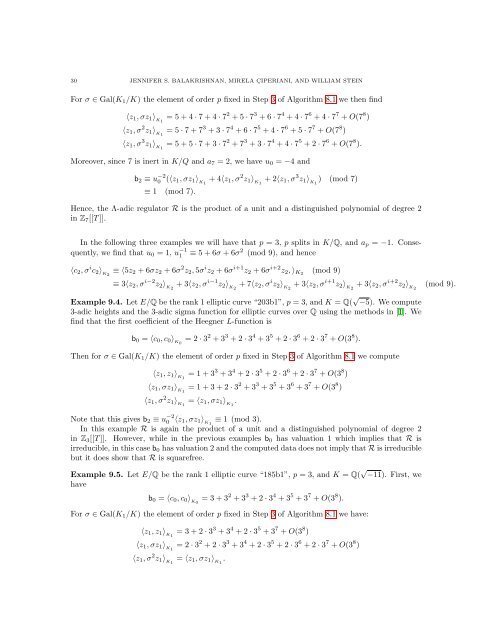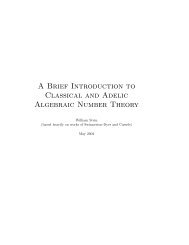p-ADIC HEIGHTS OF HEEGNER POINTS AND ANTICYCLOTOMIC ...
p-ADIC HEIGHTS OF HEEGNER POINTS AND ANTICYCLOTOMIC ...
p-ADIC HEIGHTS OF HEEGNER POINTS AND ANTICYCLOTOMIC ...
Create successful ePaper yourself
Turn your PDF publications into a flip-book with our unique Google optimized e-Paper software.
30 JENNIFER S. BALAKRISHNAN, MIRELA ÇIPERIANI, <strong>AND</strong> WILLIAM STEIN<br />
For σ ∈ Gal(K1/K) the element of order p fixed in Step 3 of Algorithm 8.1 we then find<br />
〈z1, σz1〉 K1 = 5 + 4 · 7 + 4 · 7 2 + 5 · 7 3 + 6 · 7 4 + 4 · 7 6 + 4 · 7 7 + O(7 8 )<br />
〈z1, σ 2 z1〉 K1 = 5 · 7 + 7 3 + 3 · 7 4 + 6 · 7 5 + 4 · 7 6 + 5 · 7 7 + O(7 8 )<br />
〈z1, σ 3 z1〉 K1 = 5 + 5 · 7 + 3 · 7 2 + 7 3 + 3 · 7 4 + 4 · 7 5 + 2 · 7 6 + O(7 8 ).<br />
Moreover, since 7 is inert in K/Q and a7 = 2, we have u0 = −4 and<br />
b2 ≡ u −2<br />
0 (〈z1, σz1〉 K1 + 4〈z1, σ 2 z1〉 K1 + 2〈z1, σ 3 z1〉 K1 ) (mod 7)<br />
≡ 1 (mod 7).<br />
Hence, the Λ-adic regulator R is the product of a unit and a distinguished polynomial of degree 2<br />
in Z7[[T ]].<br />
In the following three examples we will have that p = 3, p splits in K/Q, and ap = −1. Consequently,<br />
we find that u0 = 1, u −1<br />
1 ≡ 5 + 6σ + 6σ2 (mod 9), and hence<br />
〈c2, σ i c2〉 K2 ≡ 〈5z2 + 6σz2 + 6σ 2 z2, 5σ i z2 + 6σ i+1 z2 + 6σ i+2 z2, 〉K2 (mod 9)<br />
≡ 3〈z2, σ i−2 z2〉 K2 + 3〈z2, σ i−1 z2〉 K2 + 7〈z2, σ i z2〉 K2 + 3〈z2, σ i+1 z2〉 K2 + 3〈z2, σ i+2 z2〉 K2<br />
Example 9.4. Let E/Q be the rank 1 elliptic curve “203b1”, p = 3, and K = Q( √ −5). We compute<br />
3-adic heights and the 3-adic sigma function for elliptic curves over Q using the methods in [1]. We<br />
find that the first coefficient of the Heegner L-function is<br />
b0 = 〈c0, c0〉 K0 = 2 · 3 2 + 3 3 + 2 · 3 4 + 3 5 + 2 · 3 6 + 2 · 3 7 + O(3 8 ).<br />
Then for σ ∈ Gal(K1/K) the element of order p fixed in Step 3 of Algorithm 8.1 we compute<br />
〈z1, z1〉 K1 = 1 + 3 3 + 3 4 + 2 · 3 5 + 2 · 3 6 + 2 · 3 7 + O(3 8 )<br />
〈z1, σz1〉 K1 = 1 + 3 + 2 · 3 2 + 3 3 + 3 5 + 3 6 + 3 7 + O(3 8 )<br />
〈z1, σ 2 z1〉 K1 = 〈z1, σz1〉 K1 .<br />
Note that this gives b2 ≡ u −2<br />
0 〈z1, σz1〉 K1 ≡ 1 (mod 3).<br />
In this example R is again the product of a unit and a distinguished polynomial of degree 2<br />
in Z3[[T ]]. However, while in the previous examples b0 has valuation 1 which implies that R is<br />
irreducible, in this case b0 has valuation 2 and the computed data does not imply that R is irreducible<br />
but it does show that R is squarefree.<br />
Example 9.5. Let E/Q be the rank 1 elliptic curve “185b1”, p = 3, and K = Q( √ −11). First, we<br />
have<br />
b0 = 〈c0, c0〉 K0 = 3 + 3 2 + 3 3 + 2 · 3 4 + 3 5 + 3 7 + O(3 8 ).<br />
For σ ∈ Gal(K1/K) the element of order p fixed in Step 3 of Algorithm 8.1 we have:<br />
〈z1, z1〉 K1 = 3 + 2 · 3 3 + 3 4 + 2 · 3 5 + 3 7 + O(3 8 )<br />
〈z1, σz1〉 K1 = 2 · 3 2 + 2 · 3 3 + 3 4 + 2 · 3 5 + 2 · 3 6 + 2 · 3 7 + O(3 8 )<br />
〈z1, σ 2 z1〉 K1 = 〈z1, σz1〉 K1 .<br />
(mod 9).
















